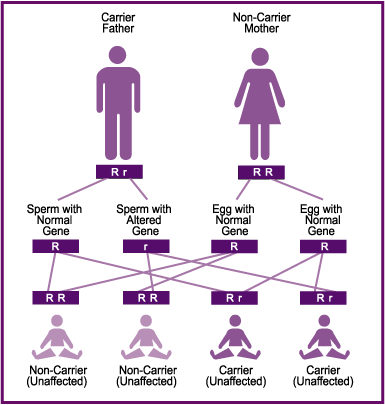Lesson 2: An Integrated Approach to Psychopathology
Attention

This graphic represents how many genetic disorders are transmitted from generation to generation...but also exemplifies that carriers do not necessarily pass on thier traits to their kids. Learning about the genetic connection with many mental disorders was a tremendous breakthrough in the field of Abnormal Psychology
Learning Outcomes
Upon completion of this lesson's material, students will be able to:
- Discuss contemporary theories of etiology (neurochemical, genetic, endocrinological, behavioral, cognitive, affective, cultural, or social/interpersonal).
- Correctly explain how the Diathesis-Stress Theory works.
- Give an example of the impact of social stigma on people suffering from psychological disorders.
Teaching
Chapter 2-An Integrative Approach to Psychopathology
What makes someone depressed? Is it some type of chemical imbalance in the brain? What about stress? What about death and loss? Maybe it is caused by genetics? Perhaps it is a result of constant frustration and negative events occurring in one’s life? Could it be caused by an unconscious reaction to the death of a pet when you were five years old? So, which explanation is correct? In the early days of Psychology (1879 to 1979), one-dimensional theories (those that only looked at one possible type of cause) were developed to explain phenomenon such as this.
Welcome to the chapter which does its’ best to walk you through etiology. Historically, there has been a rather long and difficult debate as to the causes of behavior in general. As you may know, Psychology is a very broad discipline with many theoretical viewpoints at work. Most boil down to their own explanation of how a given behavior (normal or abnormal) arises. Each theory consists of a series of assumptions and terminology designed to illustrate etiological processes. Research is then conducted to validate the extent to which a given theory is accurate. Since the field of Psychology was recognized as a separate science in 1879, most of this research has gone into validating theories in isolation from other etiological explanations. To establish itself as a new science, theorists did their best to formulate theories which explained how both normal and abnormal behavior came into existence. These “models” formed the basis of Psychology for the past 100 years. Probably the most vivid example of this divided manner of understanding etiology was the “nature versus nurture” debate. This argument questioned whether the effects of learning were more important than the impact of genetics on the development of a given behavior. So, the question that was asked was whether depression was learned OR inherited.
It wasn’t until we understood the impact of genetics on human and animal behavior, that we began to include more than one type of cause into ONE theory. These models are called multidimensional or integrative approaches. Why can’t depression be partially inherited AND partially learned? Today, most Psychologists and Psychiatrists understand that this is the case. We adhere to something called the “Diathesis-Stress Theory” which purports that most behaviors are brought on through an interaction of nature and nurture. This chapter will walk you through how contemporary theory is utilizing integrative theory to explain etiology.
Assessment
Lesson 2 Assignment - Case Study
Review the case study by clicking HERE. Write a brief paper answering the questions listed below. (The questions are also on the handout.)
1. Describe the following aspects of the etiology of Stella’s depression and anxiety as presented in the case. Simply give examples from the case that fit the areas below. You will need the text and lecture to identify these potential causes.
a. Genetic
b. neurotransmitters
c. Hormonal/endocrinological
d. Learned Helplessness
e. Conditioning (how her fear of birds was learned)
f. Emotional
g. Cultural (focus on Gender)
h. Interpersonal
2. Do your best to give a brief description of how the Diathesis-Stress Theory would explain the cause of Stella’s problems.
Lesson 2 Discussion
Take a look at www.nami.org Click on the link to “Fight Stigma.” Once there, read the material and give an example of how you can help to fight the stigma. If you wish, share an experience that you or someone you know experienced. Please be aware that these posts are available to the entire class. If you describe someone else’s experience, please be certain to change their name or other identifying information.